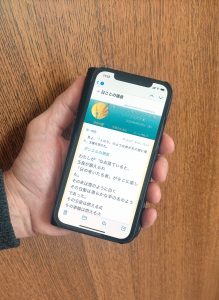
Higotonofukuin, Bible en ligne Japon
Higotonofukuin was born of a pretty simple observation. Just about everyone in the world has a digital device that they slip into their pocket, and which has become, for some, an extension of their own selves. We realised that we had a location where we could insert the Bible, so that the word of God would be as intimate as the use we make of our Keitai, our cell phone. It was not a question of taking the Bible and turning it into an app. That already existed, what was needed was to provide added value that could guide the reader, day after day, in reading the Bible. We have not, however, been reinventing the wheel – we used the liturgy of the Church to achieve our aims. The liturgy meets all our criteria for a daily reading. It offers great texts and gives the reader the opportunity to follow them day after day. Indeed, the very educational method of presenting Bible texts through the liturgy of the Mass makes it possible to pass from the liturgy to focus on biblical texts even if, for a devoted Christian, they have the texts of the Mass in their pocket. This is how we achieved two objectives in one go: the objective of being able to read ‘all’ the biblical texts over two or three years, and having a perpetual missal available at any time, even for Mass! Obviously, not ‘all’ theBible is available in the Higotonofukuin. A selection has been made so as not to lose the reader. Only the major texts, the most important ones, are made available. The objective is not to lose the reader in tedious readings but to guide them towards the essentials. If they want to read the Bible systematically from cover to cover, they can use other methods. Let us not forget that systematic, even studious, reading does not replace prayerful reading on the subway, during a break at work, on the sofa or at Mass, and for free. 日ごとの福音, Higotonofukuin, is a Japanese expression. In English we would say: ‘the Gospel for every day’. Because it is a service of the Japanese Church, in Japanese. There are at least two sites which offer a similar service in France and other sites in other countries. But nothing existed in Japanese. This is why, together with my friend Jacques, a Frenchman who has lived in Japan for twenty-two years, we decided to pool our skills in IT and the liturgy to develop this project. I collected the texts and explained to him how the liturgy worked and he translated my words into code and designed the engine that makes it possible to show the right text on the right date. We built the site that supports the project and designed the emails that send the appropriate biblical text to subscribers every day – today they number 3,600. Altogether, with users of X (formerly Twitter), Facebook, and the site itself, we now reach many thousand people daily. In a country where Christians are a tiny minority, that’s pretty good! Especially since, apart from the updates to be made from time to time, it all works pretty much by itself. The automation of tasks made possible by IT is used extensively: a lot of work was needed at the start of our project, and that work now makes it possible for us to think about possible extensions. When we talk about extensions, we are speaking of new services that would join the existing ones to expand our offer.
One of them ran for just under three years, but was related to the circumstances at the time. While the Covid crisis was in full swing and churches were closed, we took advantage of the number of our subscribers to film, live, the Sunday Mass that I celebrated with the Carmelites. One thing led to another, and at its height there were over 3,000 subscribers each Sunday. Then, at the end of the crisis, the Churches reopened little by little, the number of subscribers decreased and this particular service was closed down.
Whilst this service was connected to the circumstances at the time, there are two others in the making that appear to us to be very interesting. The first is the internationalisation of Higotonofukuin. We can see that we have a solid software infrastructure. There is nothing to stop us from developing versions in different Asian languages using the same infrastructure. The engine was developed once, and the site provides a good framework for presenting the service. They could be reused with minimum modifications for Indonesian, Tagalog or Chinese. However, we need partnerships to bring together all the necessary texts.
And of course, we must recognize that we are in the 21st century. And that ‘mobiles’ are now part of our lives. As we can have everything in our pocket on a single device, we are reluctant to carry heavy books to say the Church office. So, if the office is accessible electronically, it will be read; if it is not, we will ignore it. Fortunately, it exists in Japanese and it’s very good. You tell me it’s good? Well, no! There is an office, but itonly exists in separate books and therefore is not read. It does not exist in the Japanese online version and it deserves to be dematerialised / digitalised to find a new lease of life. This is the reading office. Of course, the office is not compulsory for clerics, but it is amazingly interesting. Basically, it is the prayerful reading, or lectio divina, of psalms, a biblical text and a commentary by one of the Fathers of the Church. It is a new opportunity to read the Bible together with authorised commentaries by Saint Augustine, Saint Cyril of Alexandria or Saint John Chrysostom: this is an opportunity not to be missed. The Church office has become an office for specialists, for monks in an abbey. For the rest of the population, including clerics, it has reached ‘deprecated’ status, to use a well-known IT term, meaning ‘obsolete’. There is only one way to popularise it again, which is to put it online. This is what we propose to do. Currently, three quarters of the texts have been collected. A little more work, and it will be finished. Starting from a magazine article with the theme of the Bible, or ‘How the Bible is offered for reading in the particular context of the Fathers of the Foreign Missions’, in this case in Japan in the 21st century, we quickly moved to talking about the liturgy. The reason is, quite simply, because the liturgy is an entry into prayerful reading of the Bible. By involving our faith, systematic reading for each day is likely to bear wonderful fruit. And what about information technology – IT? That’s the icing on the cake!
Fr François-Xavier Haure, MEP
- Higotonofukuin, Bible en ligne Japon
- Japonaises en apparat


